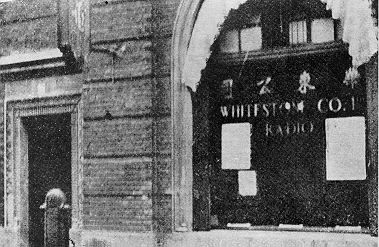 |
 |
 |
|
| |
|
|
 Broadcasting Broadcasting |
|
 |
Following
in Osborn's footsteps was Madier Ribet & Co., who installed
a broadcasting station at No. 50 , Nanjing Road with
the aid of radio broadcast, the company managed to get
its business booming. On May 15, 1924, American businessman
Dilay's Carol Corporation and Shen Bao, a Shanghai daily
newspaper, jointly opened the Carol. Radio Station,
located on a law on Route Ferguson (now Wukang Road).
The first radio program was advertised on the front
page of Shen Bao. In addition, the Carol Broadcasting
Station installed studios in Carol Corporation, Shen
Bao, Shanghai Evening News, the Paris Restaurant, and
Kobe Electrical Equipment Company, forming a broadcasting
network using special lines. In the time specified,
each of the studios delivered its scripts or music to
the Carol Broadcasting Station for transmission. This
practice set a precedent by bringing about close co-operation
between the broadcasting station, newspapers and various
circles of society, thus achieving unprecedented good
results.
The growth of radio stations gave
rise to a sharp increase in the sales of radio sets
in Shanghai (including crystal receivers and vacuum
tube radios). As might be expected, the extension of
the broadcasting influence led to governmental interference.
In August 1924, the Ministry of Communications promulgated
Provisional Regulations Concerning Assembling of Radio
Receivers. This was the first of its kind in Chinese
broadcasting history.
Stimulated by foreigners' opening
radio stations in China, Sun Sun Co. Ltd. on Nanjing
Road, owned by one of Shanghai's national capitalists,
installed a radio station of its own on the roof of
its building. Popularly known as the Sun Sun Company
Radio Station, it started its broadcasting service officially
on March 18, 1927. With a 50-watt power and a wavelength
of 370 meters, the station was designed, assembled,
installed, constructed and run by Chinese people. it
transmitted over six hours a day, broadcasting market
conditions, topical news, and such items as arias from
Guandong operas, Suzhou operas and pieces of traditional
Chinese music. Though the station stopped its transmission
in October 1929 after only two and a half years of work,
it was a milestone in the broadcasting history of Shanghai.
|
 Whitestone
Co., specialists in selling and repairing various kinds
of radio receivers
Whitestone
Co., specialists in selling and repairing various kinds
of radio receivers |
The
first radio station run by the Kuomingtang government
in Shanghai was the Shanghai Broadcasting Station. Its
predecessor was the Millionton Radio Station jointly
run by Reuters and Millington Ltd., which was bought
over by the International Telecommunication Bureau of
the Ministry of Communications and officially went into
operation on March 9, 1935. In 1936, the Municipal government
built another 5 radio stations in Wujiaochang of Jiangwan,
then a small town of Shanghai, to be administered by
the Police.
With the economy of Shanghai getting more prosperous
day by day, radio broadcasting became the most powerful
instrument for publicity and commercial advertising
became the most powerful instrument for publicity and
commercial advertising. As a result, Shanghai saw the
rapid development of its radio stations. There were
only a dozen or so stations in Shanghai before 1931.
By the end of 1932, the number of stations had dramatically
to 49, most of which were run by local Chinese. The
number of radio receivers owned by the city's residents
amounted to over 3,000 sets, and, by February 1936 reached
more than 70,000. |
|
|
On the night of Jan.23, 1923, the Osborn Radio Station,
installed on the roof of the Dollar Co., began to broadcast
its program which lasted an hour and five minutes and
included overtures, violin solos by a famous Prague
violinist, saxophone solos by George Hall of the Carlton
Orchestra, chamber music by the Golden Gate String Quartet,
dance music, local news, and news from other parts of
China, the U.S. and Europe. At that time there were
only a little over 500 radio sets in the concessions
of Shanghai. People sitting around their radio sets
listened in with amazement to miracle of a broadcast.
Even in Tianjin, a city far from Shanghai, many radio
sets received signals transmitted from the Osborn Radio
Station.
After Shanghai was reduced to the status of an isolated
island, desolation and oppressive quietness prevailed
over its radio stations. This changed at the end of
the Anti-Japanese War, which saw an enormous increase
in the number of radio stations. In 1946 there were
over a hundred stations. In May of the same year, the
Nanjing Government ordered that the broadcasting Administrative
Office and the Ministry of Communications jointly drew
up rules and regulations so as to put an end to abuses.
Under the ban only 22 radio stations run by the residents
remained. may, 1947 saw only 19 stations working, less
than a sixth of the number at the beginning of 1946
. What was worse, state-run and military radio stations
were always trying to push or elbow them out, so that
on the eve of liberation many a station run by local
people was on the verge of elimination. |
|
With
the liberation of Shanghai the Shanghai People's Broadcasting
Station was established. Privately-owned radio station
were checked on, overhauled, consolidated and transformed.
In October 1952, the 16 private stations, of their own
accord, went in for joint state-private ownership, forming
the Shanghai United Broadcasting Station, which functioned
under the guidance of the Shanghai People's Broadcasting
Station. In September 1953, the Shanghai United Broadcasting
Station merged with the Shanghai People's Broadcasting
Station.
Today, the Shanghai People's Broadcasting Station offers
six different programs and six frequencies (five medium-wave
programs and one FM stereo program), playing an increasingly
important part in the daily and political life of the
Shanghai people. |
|
|
|
|
|
|
 |
 |
 |
|
|
|
|
|
|
|


